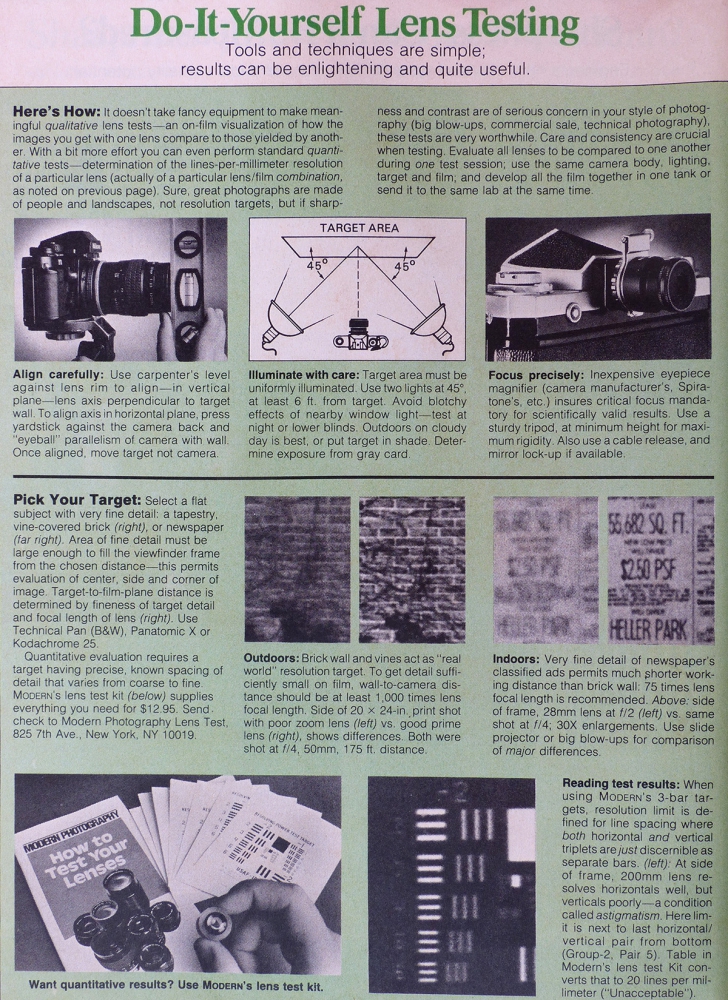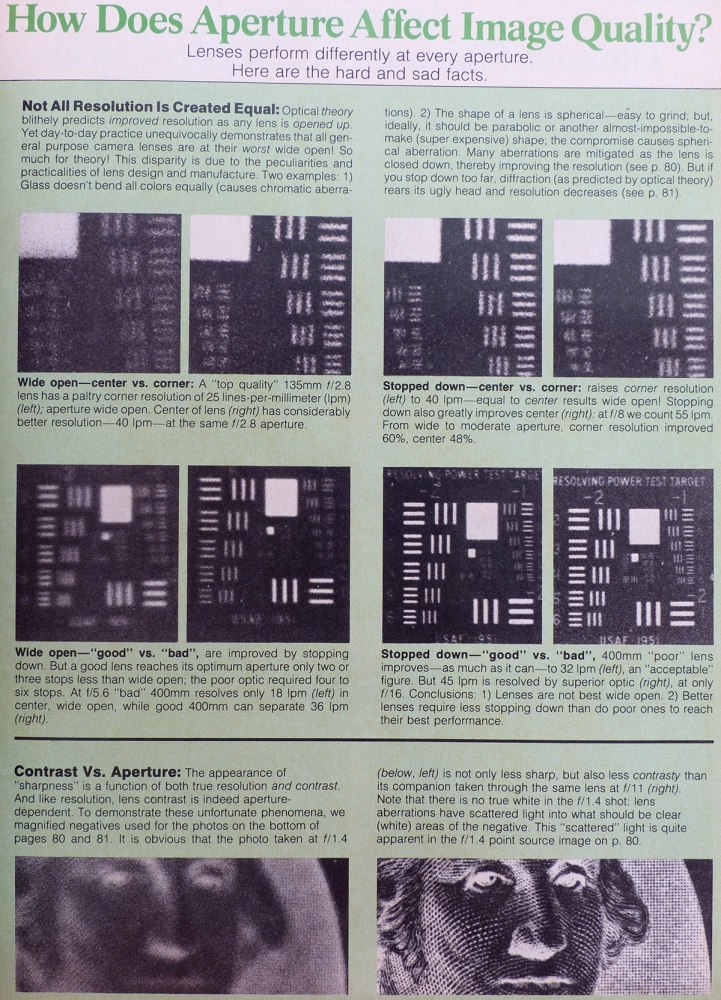| View previous topic :: View next topic |
| Author |
Message |
Gerald


Joined: 25 Mar 2014
Posts: 1196
Location: Brazil
|
 Posted: Thu Apr 10, 2014 12:55 pm Post subject: LENSES: Facts and Fallacies - Part II Posted: Thu Apr 10, 2014 12:55 pm Post subject: LENSES: Facts and Fallacies - Part II |
 |
|
Gerald wrote:
This part of the article explains how to test yourself your lenses using conventional techniques. Thirty years ago, printers for home use were virtually nonexistent and personal computers were not as popular as today. Modern Photography even sold a kit with several test charts and a magnifying glass. Today, printers are ubiquitous, so you can print yourself the necessary test charts. And with digital cameras you do not need to spend a fortune on films to test your lenses.
The article also discusses how the aperture of a lens affects the image quality. As most of you know, besides the image quality, the aperture affects the exposure, depth of field and bokeh.
I would like to remember that the comments in the article are valid for most photographic lenses, but, of course, there are exceptions. For example, there are lenses with correction so good that the peak performance already occurs at wide open.


_________________
If raindrops were perfect lenses, the rainbow did not exist.
Last edited by Gerald on Sun Mar 05, 2017 5:25 pm; edited 1 time in total |
|
| Back to top |
|
 |
sichko


Joined: 20 Jun 2008
Posts: 2475
Location: South West UK
|
 Posted: Thu Apr 10, 2014 1:38 pm Post subject: Posted: Thu Apr 10, 2014 1:38 pm Post subject: |
 |
|
sichko wrote:
The article is confusing. Quotes ...
Optical theory blithely predicts improved resolution as any lens is opened up.
Many aberrations are mitigated as the lens is closed down, thereby improving the resolution. But if yoy step down too far, diffraction (as predicted by optical theory) rears it's ugly head and resolution decreases.
The quotes imply that diffraction only is satisfactorily explained by optical theory, but that aberrations are not. In fact aberrations are also explained by theory.
_________________
John |
|
| Back to top |
|
 |
Gerald


Joined: 25 Mar 2014
Posts: 1196
Location: Brazil
|
 Posted: Thu Apr 10, 2014 1:59 pm Post subject: Posted: Thu Apr 10, 2014 1:59 pm Post subject: |
 |
|
Gerald wrote:
| sichko wrote: |
The article is confusing. Quotes ...
Optical theory blithely predicts improved resolution as any lens is opened up. |
Here he is talking about lenses totally corrected from aberrations (ideal lenses), whose resolutions are limited only by difraction.
| sichko wrote: |
The article is confusing. Quotes ...
Many aberrations are mitigated as the lens is closed down, thereby improving the resolution. But if yoy step down too far, diffraction (as predicted by optical theory) rears it's ugly head and resolution decreases. |
Now he is talking about real lenses. For large apertures, the performance is basically limited by the (residual) aberrations, and for smaller appertures, by a variable mixture of aberrations and difraction.
_________________
If raindrops were perfect lenses, the rainbow did not exist. |
|
| Back to top |
|
 |
guardian

Joined: 18 Mar 2009
Posts: 1746
|
 Posted: Thu Apr 10, 2014 8:39 pm Post subject: Posted: Thu Apr 10, 2014 8:39 pm Post subject: |
 |
|
guardian wrote:
I wonder whether it's possible today to buy, new, one of those handy lens test kits.
No doubt a substitute could be put together piecemeal. But having everything together in a kit, well thought through and designed as an ensemble, would be desirable. |
|
| Back to top |
|
 |
danfromm

Joined: 04 Sep 2011
Posts: 595
|
 Posted: Thu Apr 10, 2014 8:44 pm Post subject: Posted: Thu Apr 10, 2014 8:44 pm Post subject: |
 |
|
danfromm wrote:
| guardian wrote: |
I wonder whether it's possible today to buy, new, one of those handy lens test kits.
No doubt a substitute could be put together piecemeal. But having everything together in a kit, well thought through and designed as an ensemble, would be desirable. |
http://www.edmundoptics.com/ will happily sell you a USAF 1951 chart on paper (they have them on glass for testing microscope objectives too) and a suitable magnifier. Edmund offers other targets as well, look around their site. |
|
| Back to top |
|
 |
ForenSeil


Joined: 15 Apr 2011
Posts: 2726
Location: Kiel, Germany.
|
 Posted: Thu Apr 10, 2014 9:15 pm Post subject: Posted: Thu Apr 10, 2014 9:15 pm Post subject: |
 |
|
ForenSeil wrote:
Should also work fine: Click here to see on Ebay.de
3,2-100lp/mm DINA4 Testchart for 1:40 magnification ratio (2,1m with 50mm lens).
Only problem is that with most good 50mm lenses normal digital sensors won't be high resolving enough and you will need to take photos with high resolving B/W film like Efke 25 - and there with most analog bodies shutter vibration should be limiting.
_________________
I'm not a collector, I'm a tester 
My camera: Sony A7+Zeiss Sonnar 55/1.8
Current favourite lenses (I have many more):
A few macro-Tominons, Samyang 12/2.8, Noritsu 50.7/9.5, Rodagon 105/5.6 on bellows, Samyang 135/2, Nikon ED 180/2.8, Leitz Elmar-R 250/4, Celestron C8 2000mm F10
Most wanted: Samyang 24/1.4, Samyang 35/1.4, Nikon 200/2 ED
My Blog: http://picturechemistry.own-blog.com/
(German language) |
|
| Back to top |
|
 |
|
|
|
You cannot post new topics in this forum
You cannot reply to topics in this forum
You cannot edit your posts in this forum
You cannot delete your posts in this forum
You cannot vote in polls in this forum
|
